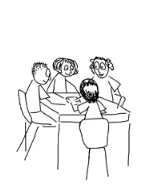Sequencing activities
Sequencing activities simply involve students putting a sequence of steps in a process or procedure in the correct order. For instance, they might be about the steps involved in fitting an electrical switch, setting up and naming a word processing file or assembling equipment. Sequencing activities not only assist students to remember the order in cases where this is important, but give them a language to talk about the process eg, the names of the steps and the equipment used for them. Sequencing activities could involve text instructions, pictures and/or diagrams or combinations of these. If used in groups or pairs then, in order to promote cooperation and discussion, the set of instructions are cut into strips for students in pairs or groups, to assemble correctly.
Uses of sequencing activities
Sequencing activities can be used in a variety of ways, for instance:
- as a revision strategy at the beginning or end of a session,
- to turn passive reading of processes in text books and manual into meaningful activities,
- to promote student discussion during a class •to change literacy mode during a teaching session,
- to bring students together during long practical workshops where they would primarily be working alone.

Benefits of sequencing activities
Sequencing activities have a number of benefits they:
- assist students remember a process,
- help students learn the names of the steps in a process and the tools used,
- encourage students to use the language associated with a process,
- promote student sharing of their understanding if used with pairs or small groups,
- Developing a sequencing activity for your teaching.
You can develop a sequencing activity from any set of instructions in a manual or textbook even if they are not already written in a step by step form. All you need to do is to rewrite the steps in clear simple sentences that are spaced out on the page to allow for cutting. Order the list of clearly in separate sentences and arrange them in a table for ease of cutting. Cut the pieces and place in an envelope or clip them together with a bulldog clip – make one set per pair or small group.
How to paint clouds on a ceiling
Michelangelo painted a ceiling and you can too! Here's how to create an airy, cloud-filled room. Ensure that you do not cut with wavy lines that can be matched up like a jigsaw afterwards because this defeats the purpose of promoting thinking about steps and language.
Steps:
- Remove or cover furniture and put down a drop cloth.
- Paint the ceiling blue and let it dry.
- Pour white paint into a roller tray.
- Holding a sponge flat, dip it into the paint.
- Dab the paint-filled sponge on the ceiling.
- Make clouds in a free-form shape. You may want to have some pictures of clouds on hand for reference.
- Use more paint in the centre of the cloud, and less paint as you move out toward the edges.
- Leave some areas of blue showing through the white for a light, transparent look.
- Make clouds of different sizes.
- Cover the ceiling evenly, but randomly, with clouds.
Follow as for Cloze or Matching or True or False.
This activity has been adapted from eHow - How to paint clouds on a ceiling http://www.ehow.com/how_12569_paint-clouds-ceiling.html accessed 19 June, 2005.
